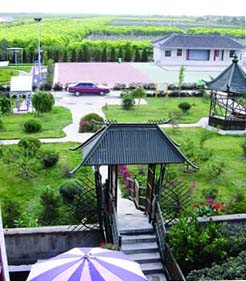
It's a 40-minute-trip by water to Chongming Island at the mouth of the Yangtze River. Chongming is China's third-largest island and Shanghai's only county and it provides an ideal escape from Shanghai's urban concrete and steel into a pastoral paradise.
When our car drove away from Nanmen, a hustling and bustling port near the island county's downtown area, the whole world quickly quieted down with only the sound of the wind whistling in our ears.
Trees were flourishing on each side of the road and our Chongming guide said by 2020 most of the county would be covered by foliage.
As an agricultural county free from water, exhaust and noise pollution, Chongming has made ecological tourism one of its target projects. The "nongjiale" concept, a newly-developed tourist package idea involving living in farm houses and eating farm food, was a major feature of this year's Shanghai Tourism Festival.
Qianwei in 1998 was the first village to tap into "nongjiale". The village emerged from an area of tidal-flats more than three decades ago and was created by a 17-year-old youth who was village secretary at the time.
Today, with the development of tourism and agriculture in the village, its 753 residents are now listed as living in one of the World's Top-500 Ecological Villages.
Willows and bushes grow on both sides of a road into the village, giving a quite different impression from other traditional villages which have clay roads and weeds growing beside them.
The first tourist spot in the village is Yingzhou which shows how local people lived in the late Qing Dynasty (1644-1911). It has straw-made houses containing antique furniture. Visitors can see bridal chambers and kitchens and try their hand on one-wheel handcarts, at milling and at the spinning wheel.
The whole area is also like a huge amusement park with angling, horse-riding bike-riding and boating.
The wetlands park provides a great touch with nature, with a wooden bridge winding among the reeds leading further out over the water. At the end of the bridge, visitors can view a vast water vista from a five-storey building which also contains a pictorial history of the island.
In the village, some 25 households are licensed to offer accommodation to visitors and five have a 3-star hotel rating.
Visitors should not worry about accommodation in the houses. Most are three-storeyed buildings which are very well decorated and these family hotels can be easily identified from the red lanterns hanging in front of them.
Orange Picking
Our second stop was in Lvhua Village, a destination shown in this year's tourism festival. Its orange orchards have become the village's most attractive feature. We arrived there after a little drizzle, and a pleasant earthy smell greeted our noses when we got out of the car. The leaves of the orange trees shone with a pure green colour and I thought that maybe the rain had just washed the dust from the leaves. However, our guide reminded us that the island was a long way away from the pollution of the city.
During the month-long tourism gala, tourists are allowed to pick oranges by themselves and our guide said that in late September or early October visitors may have the opportunity to pick more mature fruit.
Picking oranges is not the only the "entertainment" offered in the village - a new item is the cricket fighting competition.
Lvhua Village has just been opened to tourism and only 10 families are currently permitted to offer accommodation to visitors.
Fishing Village
Another village newly recommended for "nongjiale" is Yingdong which also offers fishing as a tourist attraction.
SARS may have had a severe effect on tourism elsewhere but on Chongming Island tourist numbers this year have been greater than last year.
"Chongming is the back garden of downtown Shanghai," the guide said. "It puts city dwellers back in close touch with nature."
(Shanghai Star September 24, 2003)
|

